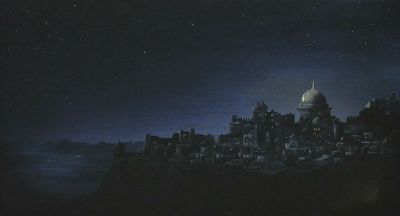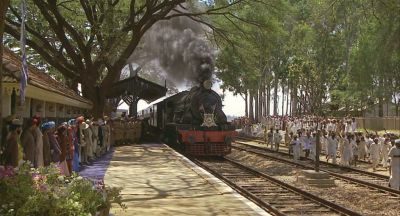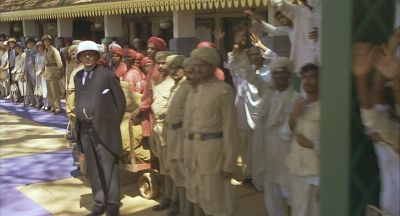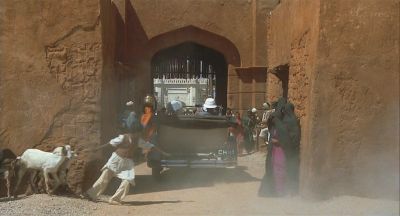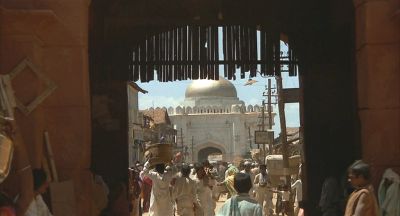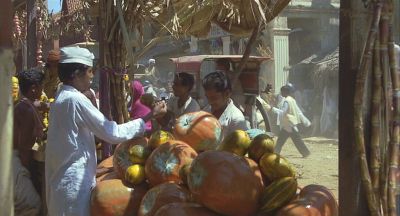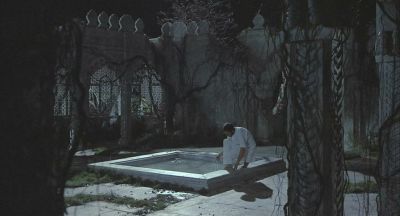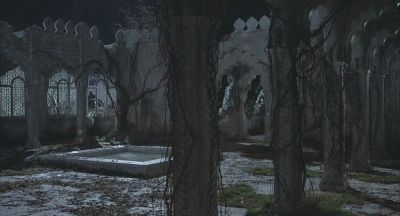Chandrapore - fictional city in 'A Passage To India'
E.M. Forster based his fictional city of Chandrapore on Bankipur, a suburb east of Patna, in the state of Bihar. It was built by the British in 1771 on the banks of the wide Ganges river. They tried to recreate the typical atmosphere of an English village, with the church on a village green. That green became the Gandhi Maidan, where Adela and Ronny would later watch Polo matches. The Bankipur Club is there, with a turfed terrace over-looking the river. Even the mosque to which Mrs. Moore slipped out can be found, at the head of Asoka Rajpath which goes through Muradpur and past Fielding’s College to the city.
In the film, we never see an overview of Chandrapore, apart from in one brief shot, obviously a model, of the city at night.
Forster describes his 'Chandrapore' at the beginning of the novel: 'Except for the Marabar Caves - and they are twenty miles off - the city of Chandrapore presents nothing extraordinary. Edged rather than washed by the river Ganges, it trails for a couple of miles along the bank, scarcely distinguishable from the rubbish it deposits so freely. There are no bathing steps on the river front, and bazaars shut out the wide and shifting panorama of the stream. The streets are mean, the temples ineffective, and though a few fine houses exist they are hidden away in gardens or down alleys whose filth deters all but the invited guest. Chandrapore was never large or beautiful, but two hundred years ago [in 1924] it lay on the road between Upper India, then imperial, and the sea, and the fine houses date from that period. The zest for decoration stopped in the eighteenth century, nor was it ever democratic. In the bazaars there is no painting and scarcely any carving. The very wood seems made of mud, the inhabitants of mud moving. So abased, so monotonous is everything that meets the eye, that when the Ganges comes down it might be expected to wash the excresence back into the soil. Houses do fall, people are drowned and left rotting, but the general outline of the town persists, swelling here, shrinking there, like some low but indestructible form of life. Inland, the prospect alters. There is an oval maidan, and a long sallow hospital. Houses belonging to Eurasians stand on the high ground by the railway station. Beyond the railway - which runs parallel to the river - the land sinks, then rises again rather steeply. On this second rise is laid out the little Civil Station.'
This, then, was the canvas that Lean had to work with when planning his film. Although the actual caves that Forster based his 'Marabar Caves' on were just 45 miles away from Bankipur, the area was not suitable for what Lean had in mind. Also, the government said that there could be no filming there because of bandits - still a problem today. David came to India scouting locations, and found the ancient Swiss steam locomotives and their perfect scenery on the Nilgiri Mountain Railway, to the south west of Bangalore. The key location, though, was the Marabar Caves. The perfect place was found by Eddie Fowlie at Savandurga, just 30 miles west of Bangalore, which thus became the centre of operations.
Our first view of Chandrapore is when the 'Imperial Indian Mail' train arrives from Bombay. The actual station used in the film was at Dodballapur, about 23 miles north of Bangalore, on the main line via Dharmavaram Junction to Bombay. You can see two photos of how the station looks today on the IRFCA picture gallery here and here. Though it is not obvious in the film, two stations were used for Chandrapore. This one has broad-gauge tracks, whilst the station used for the expedition to the Marabar Caves is metre gauge. For more details on the metre gauge station, see my Coonoor Station page.
The Bazaar
After the station, we are shown the Turtons, Ronny Heaslop's party, and others driving through the bazaar to the Civil Lines, where the English community lived. The bazaar was constructed by Lean on a 'backlot' that was housed in the vast grounds of the Maharajah's palace in Bangalore, just seven minutes away from the West End Hotel where the cast and crew would be based. The palace used to belong (still does?) to the Maharajah of Mysore. Located on Palace Road, it is known as 'The Bangalore Palace' today, and is a popular tourist attraction, though rather expensive to look around: a foreigner's ticket was 400rs + 685rs for the camera charge.
You might be wondering why Lean didn't use a real Indian bazaar, when so many are available, and in many cases little changed from the 1920's. KB quotes Lean saying 'In India, they are film-mad. Its their great entertainment. As soon as you set up a camera you've got three thousand people round you and you can't work. I think you can work much better on sets, because you can make it a concen-trated bazaar, which is more of a bazaar than a real bazaar. Its the difference between a painting and a photograph. You can make the painting much better.'
Though completely out of sequence, the next two stills show Mr Fielding being driven through the bazaar in a tonga, after Dr Aziz has been arrested. I included them here to keep the images of the bazaar together.
Dr Aziz's house
I assume that Dr Aziz's house and yard were also filmed in the Bangalore backlot. Some of the buildings nearby look original, so maybe they were already present. Here we see Dr Aziz and his friend, the lawyer Mahmoud Ali, bicycling in to the yard in front of Dr Aziz's house.
The Mosque
At the club, a musical play is put on to entertain the members and their guests. Mrs Moore has already seen it in London, and new to India, she leaves the Club to explore, and finds an old mosque that she enters. Inside, she finds Dr Aziz, a meeting that startles them both until they begin to talk. The mosque is obviously a studio set, but is well made, and typical of many small mosques found throughout India. The leaves on the floor remind me of a scene in Lean's 'Dr Zhivago', when Yuri and Lara leave the library at Yuryatin.

